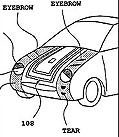
« PREVIOUS ENTRY
The new Hiptop!
NEXT ENTRY »
Blobology

Automobiles have a strange relationship to human emotion. Much like the Internet, a car gives its driver a sense of pseudoanomity and isolation, coupled with a sudden sense of enhanced abilities. That produces the same sort of id-release and overblown emotions that one typically sees in discussion boards and email. I’d argue that dense traffic behaves kind of like a flame war.
Yet while cars stir the emotions, they don’t allow us many ways to communicate them. This is particularly weird when you consider that highways are insanely dangerous places that could really benefit from greater communication between each hurtling 2-ton vehicle. But cars only give us very few ways of explaining our intent or feelings to other drivers. We can blast the horn (annoying), use the body English of the car itself (incredibly dangerous), flick our turn signals (accurate but useless for communicating anything other than “I’m turning”), or wave frantically to other drivers (simply cryptic).
This is why I was intrigued to open the New York Times today and find a story about some Toyota designers who have patented a system that would give a car “expressions” like a human. The system would instal lighting on the hood, as well as “eyebrow” accents over the headlights; it would also control the antenna and window wipers to communicate emotion. The result, as the Times reports, is an interesting array of ways to “talk” to other drivers or pedestrians:
For anger, the hood lighting color glows red while the eyebrow lights up and the headlights, antenna and height are in standard position.
But if the driver is joyful, the car may “wink” to let another car go first by changing the hood lighting and the eyebrow to orange, shading the headlight so it appears half-closed and causing the antenna to vibrate from left to right as if it were wagging.
The chart also indicates that a car with mechanical trouble might “cry” by displaying dark blue hood lighting, a shaded headlight, a lit eyebrow and a blinking “tear” light.
And if the “sudden appearance of a vehicle or pedestrian causes sudden braking,” the car will express surprise by having its hood lights turn orange, its eyebrows light up red, the headlights shaded and the vehicle height lowered in the rear.
The question is whether these “emotions” would be too cacophonous. Could we really figure out what the cars were saying to us?
Similarly, I once had an idea for a simpler, stripped-down improvement upon brake lights. The problem with brake lights is that they don’t communicate very well how hard or how suddenly the driver is applying the brakes. Sure, you can visually see whether the car ahead of you is rapidly slowing down — except in low visibility, when it’s often hard to judge the speed of a vehicle ahead of you. Some brake lights go on more “intensely” when they’re applied hard, but intensity can also be tricky to judge from a distance. So why not re-engineer brake lights to give a bit more information? Put a set of three brake lights on each side of the car, and have them light up in combinations that indicate how rapidly the driver is braking: One light when the brakes are being applied gently, two lights when they’re being applied more firmly, and all three when the driver is really slamming them hard.
I'm Clive Thompson, the author of Smarter Than You Think: How Technology is Changing Our Minds for the Better (Penguin Press). You can order the book now at Amazon, Barnes and Noble, Powells, Indiebound, or through your local bookstore! I'm also a contributing writer for the New York Times Magazine and a columnist for Wired magazine. Email is here or ping me via the antiquated form of AOL IM (pomeranian99).

ECHO
Erik Weissengruber
Vespaboy
Terri Senft
Tom Igoe
El Rey Del Art
Morgan Noel
Maura Johnston
Cori Eckert
Heather Gold
Andrew Hearst
Chris Allbritton
Bret Dawson
Michele Tepper
Sharyn November
Gail Jaitin
Barnaby Marshall
Frankly, I'd Rather Not
The Shifted Librarian
Ryan Bigge
Nick Denton
Howard Sherman's Nuggets
Serial Deviant
Ellen McDermott
Jeff Liu
Marc Kelsey
Chris Shieh
Iron Monkey
Diversions
Rob Toole
Donut Rock City
Ross Judson
Idle Words
J-Walk Blog
The Antic Muse
Tribblescape
Little Things
Jeff Heer
Abstract Dynamics
Snark Market
Plastic Bag
Sensory Impact
Incoming Signals
MemeFirst
MemoryCard
Majikthise
Ludonauts
Boing Boing
Slashdot
Atrios
Smart Mobs
Plastic
Ludology.org
The Feature
Gizmodo
game girl
Mindjack
Techdirt Wireless News
Corante Gaming blog
Corante Social Software blog
ECHO
SciTech Daily
Arts and Letters Daily
Textually.org
BlogPulse
Robots.net
Alan Reiter's Wireless Data Weblog
Brad DeLong
Viral Marketing Blog
Gameblogs
Slashdot Games